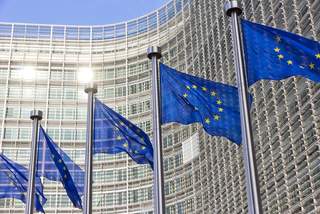
© Van der Wolf/Fotolia
European Growth Outlook: Protectionism as a brake on the economy
Increasing protectionism weighs on the eurozone
The tariff increases gradually introduced by the US government since the beginning of the year mark a historic turning point in global trade. The new average US tariff rate is above the level of the Great Depression in the 1930s and is causing considerable uncertainty among companies. The export-orientated eurozone is particularly affected: Delays in supply chains, falling demand from third countries - particularly from Asia - and the appreciation of the euro against the US dollar are weighing on the price competitiveness of European suppliers.
According to estimates, increasing protectionism could noticeably dampen gross domestic product in the eurozone as early as this year - by a good 0.3 percentage points, depending on the intensity of the trade conflict and the trade policy countermeasures. The decline in global trade forecast by the International Monetary Fund to just 1.7 per cent growth in 2025 (after 3.8 per cent in the previous year) also underlines the broad impact of the trade conflicts, which extend beyond transatlantic relations.
Public investment boosts demand in the medium term
Fiscal policy is providing a positive impetus: many member states, especially Germany, have significantly increased their public investment - with a focus on defence and infrastructure. These measures are likely to have an increasing impact on growth from 2026. However, the effects will remain limited in the short term, not least due to the delays in implementation that are typical of large investment projects. There is also the question of how these fiscal projects can be harmonised with European fiscal rules, particularly in Germany.
Muted recovery, continuing uncertainty
After a weak year in 2024, the outlook for 2025 remains cautious. Despite robust labour markets and increased real incomes, we expect growth of only 0.8 per cent for the eurozone - significantly below expectations at the start of the year (one per cent).
Developments in the four largest member states are mixed:
- Germany: minus 0.2 per cent
- France: plus 0.6 per cent
- Italy: plus 0.4 per cent
- Spain: plus 2.5 per cent
The inflation rate is likely to stabilise at 2.2 percent despite any counter-tariffs. Growth, exchange rate and customs effects are currently largely cancelling each other out. However, geopolitical uncertainty and unclear future trade policy remain a key forecasting risk.
Recommendations for a resilient European economy
Determined political measures are required to meet the economic challenges and secure Europe's competitiveness in the long term. The growth forces in the eurozone should be supported by the monetary policy of the European Central Bank and promoted by a more active fiscal policy in the member states with increased defence and infrastructure needs. Targeted reforms to strengthen growth potential are necessary, particularly in the labour market, in the framework conditions for private investment - for example by cutting red tape, reducing reporting obligations and deepening the single market - and through an aggressive innovation agenda at national and European level in line with the recommendations of the Draghi Report and the Compass. In addition, the conclusion of new trade agreements should be examined.
The European economy faces major challenges in 2025, but also has the opportunity to lay the foundations for sustainable and future-oriented growth through a smart economic and structural policy. The decisive factor will be whether Europe can respond to the pressing tasks in a determined and coordinated manner. Only if the right course is set now can the continent's competitiveness be secured in the long term. You can read the full growth outlook in our publication.



